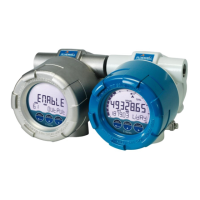E018-P
FW_E018-P_M_v0302-02_EN Page 47
Reed switch
The unit can be used with flowmeters which have a reed switch. To avoid pulse bounce from the
reed switch, it is advised to select REED LP – low-pass noise filter, which limits the maximum input
frequency (see
5: FLOWMETER[»25]). Make sure the contact resistance of the reed switch is less
than 1V@2uA=500 kOhm.
S2
Common system ground
S3
REED-LP*
┴
R
3V
S1
MEM
Fig.34: Terminals S1-S2: Reed switch input
NAMUR signal
The unit is suitable for flowmeters with a NAMUR signal (units with PX cannot power the NAMUR
sensor). If required the NAMUR sensor can be supplied via the 8.2 V sensor supply (terminal P3),
only available with power supply type PD. See
5: FLOWMETER[»25] for more information.
S1
S2
S3
P3
↓
+
J1-J2
8.2V
Common system ground
R
┴
MEM
Fig.35: Terminals S1-S2 and P3: NAMUR input signal

